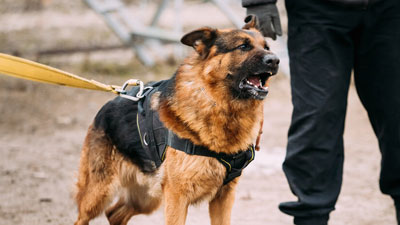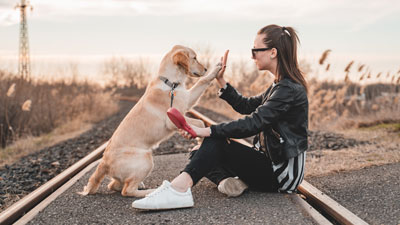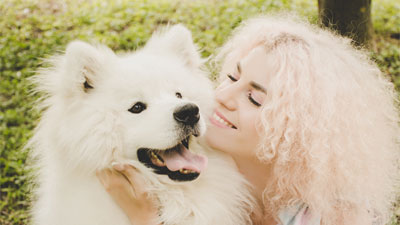- Size
- Smallest
- Small
- Small to Medium
- Medium
- Large
- Giant
- Characteristics
- Smartest
- Hypoallergenic
- Fluffy
- Best Guard
- Best Family
- Best for Kids
- Low Shedding
- Healthiest
- Police Dogs
- Most Calm
- Quietest
- Color
- White
- Black
- Grey
- Brown
- Blue
- Red
- Coat
- Hairless
- Short
- Long
- Origin
- Japan
- China
- Australia
- Germany
- Italy
- United States
- France
- Group
- Hound
- Terrier
- Herding
- Toy
- Working
- Sporting
How Do Dogs Show Their Emotions?

Photo by Andrew Leu on Unsplash
Dogs have a way of capturing our hearts with their unconditional love, loyalty, and playful nature. But how do dogs actually express their emotions? Can we interpret their wagging tails, barks, or body language to understand what they are feeling?
In this article, we will explore the various ways dogs demonstrate their emotions, shedding light on how to decode their signals and strengthen our bond with these remarkable animals.
Here are 10 common ways dogs express their emotions:
1. Tail Wagging
One of the most recognizable expressions of a dog's emotions is tail wagging. However, contrary to popular belief, not all tail wags indicate happiness. The position of the tail and the speed of the wag can convey different emotions. A high and fast wag usually signifies excitement or joy, while a low and slow wag may indicate caution or uncertainty. Paying attention to the context and other accompanying body language can help decipher the true meaning behind a dog's wagging tail.
2. Facial Expressions
Similar to humans, dogs use facial expressions to convey their emotions. They have a remarkable ability to raise their eyebrows, widen their eyes, or slightly tilt their heads to communicate their feelings. For example, when a dog is happy or content, their eyes may appear relaxed, their mouth slightly open, and their tongue lolling out. On the other hand, if a dog feels threatened or anxious, their eyes may become wide and their body tense. Observing these subtle facial cues can provide valuable insights into a dog's emotional state.
3. Body Language
A dog's body language is a rich source of information when it comes to understanding their emotions. Some common body postures include:
Play bow: When a dog lowers its front end and raises its back end, often accompanied by a wagging tail, it is an invitation to play. This posture signals excitement, joy, and readiness for interaction.
Ears: The position of a dog's ears can reveal a lot about their emotional state. Relaxed ears indicate a calm and content dog, while erect ears typically signal alertness or interest. Flattened ears, however, may indicate fear, anxiety, or submission.
Posture: A relaxed and loose body posture suggests a happy and comfortable dog. Conversely, if a dog's body is tense or stiff, it may indicate fear, aggression, or stress. Understanding a dog's overall body language can help interpret their emotions more accurately.
4. Vocalizations
Dogs use a variety of sounds to express their emotions and communicate with both humans and other animals. Some common vocalizations and their associated emotions are:
Barking: Dogs bark for various reasons, such as to alert their owners to potential dangers, to express excitement, or to seek attention. The pitch, tone, and intensity of the bark can provide clues about a dog's emotional state.
Growling: Growling is often associated with feelings of aggression or discomfort. It serves as a warning signal to others, indicating that the dog is feeling threatened and wants to establish personal boundaries.
Howling: Howling is a form of vocalization in which a dog expresses loneliness, anxiety, or a response to certain sounds. It is an instinctive behavior rooted in their ancestral past and is often used to communicate over long distances.
5. Raised Hackles
Raised hackles, the line of hair along a dog's back, are often associated with heightened arousal or alertness. Contrary to popular belief, this doesn't always indicate aggression. Dogs may raise their hackles in response to excitement, curiosity, or even anxiety. Reading the overall context and other body language cues is crucial in interpreting this signal accurately.
Related: The 10 Dog Breeds with Prominent Hackles
6. Licking and Nudging
Dogs often show affection and seek comfort by licking their owners or nuzzling against them. Licking can be a sign of submission, adoration, or an attempt to communicate a need. Similarly, a gentle nudge against your leg or hand can be seen as a friendly gesture, showing trust and a desire for interaction.
7. Tail and Ear Position
In addition to tail wagging, the position of a dog's tail at rest can provide insights into their emotions. A relaxed tail held in a neutral position typically indicates a calm and content dog. A tucked tail, on the other hand, maybe a sign of fear or submission. Similarly, ears held forward reflect attentiveness, while ears pinned back usually indicate fear, anxiety, or discomfort.
8. Physical Contact
Dogs are social animals and often seek physical contact with their owners or other dogs to establish emotional connections. They may lean against your legs, lie close to you, or curl up on your lap, exhibiting their desire for affection and closeness. These gestures demonstrate their trust and reliance on their human counterparts for emotional support.
9. Gaze and Eye Contact
Dogs use eye contact to establish connections and convey emotions. A soft, relaxed gaze typically signifies trust and affection, while prolonged staring may indicate a challenge or discomfort. Reading a dog's eyes provides essential cues about their emotional well-being.
Related: How To Train Your Dog To Eye Contact
10. Yawning and Other Calming Signals
Dogs exhibit various calming signals, such as yawning, lip-licking, and turning away, in situations that induce stress or tension. Recognizing these signals allows pet owners to alleviate potential sources of discomfort and create a supportive environment for their dogs.
Conclusion
Understanding how dogs express their emotions is crucial for building a strong bond and ensuring their overall well-being. By paying attention to their tail wagging, facial expressions, body language, vocalizations, and physical contact, we can decipher their feelings and respond appropriately. Dogs are incredible communicators, and by learning their unique language, we can provide them with the love, care, and understanding they deserve.
Decoding the intricate language of dog body signals involves recognizing that each cue is part of a comprehensive package. When interpreting a dog's communication, it's essential to consider various signals, ranging from tail height to eye shape and more.
You May Also Like
 Dog BreedsThe 10 Dog Breeds with Prominent Hackles
Dog BreedsThe 10 Dog Breeds with Prominent Hackles Dog BehaviorWhat Does It Mean When A Dog's Hackles Stand Up?
Dog BehaviorWhat Does It Mean When A Dog's Hackles Stand Up? Dog BehaviorThe 6 Common Dog Sounds and Their Meanings
Dog BehaviorThe 6 Common Dog Sounds and Their Meanings Help & AdviceWhat Is The Hardest Dog Trick?
Help & AdviceWhat Is The Hardest Dog Trick? Dog Training TipsHere are the 7 Most Important Dog Commands
Dog Training TipsHere are the 7 Most Important Dog Commands Dog Training Tips5 Easy Steps: How to Teach a Dog to Smile
Dog Training Tips5 Easy Steps: How to Teach a Dog to Smile